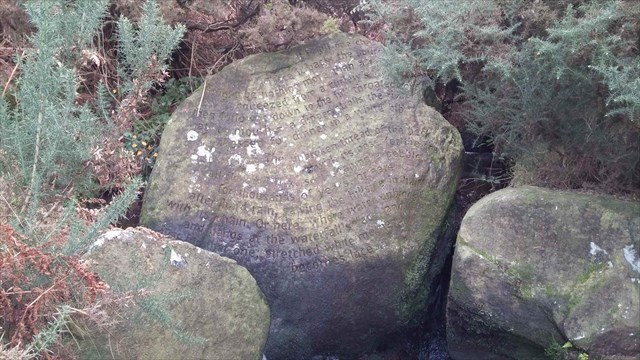Stanza Stones: 'Beck'

The cache, a camo-taped screw-capped glass jar, is hidden in a lovely secluded spot close to 'Beck', one of seven poems carved on rock (the Stanza Stones) on the moorlands of the South Pennines area of Yorkshire. All the poems feature water in one of its many forms.
To reach the cache location:
Park roadside on Maxwell Road @ N 53 55.162 W 1 48.578, carefully cross the (busy) main road and enter the woodland through the small gate opposite. Head left and make your way up the stepped path to N 53 55.138 W 1 48.588 the start of a small trail climbing steeply up the east side of the beck woods. Follow this to the top then head right and down towards the footbridge. On the way down on your left you will see another small trail heading steeply up the slope east of the beck - with a Stanza Stones marker post pointing the way.
Climb up some 30-40m to where there are some large rocks on both sides of the path and another marker post indicating the way down to the beck, past a large gorse bush, to the Beck Stone and the cache location nearby.
 Backstone Beck rises high on Ilkley Moor and in its short course to join the River Wharfe in the valley below it tumbles down deep ravines scoured into the peat. A footpath runs for most of its course alongside the beck and, about half way down the hillside, a path through the gorse leads you to a twist and dip in the stream.
Backstone Beck rises high on Ilkley Moor and in its short course to join the River Wharfe in the valley below it tumbles down deep ravines scoured into the peat. A footpath runs for most of its course alongside the beck and, about half way down the hillside, a path through the gorse leads you to a twist and dip in the stream.
Here the water cascades either side of a boulder, dislodged centuries ago, and now resting upright on the stream bed. A small grassy knoll forms a natural viewing platform.
On the rock is the poem ‘Beck’ written by the renowned Yorkshire poet, Simon Armitage, and carved – taking around ten minutes per letter – by stone artist, Pip Hall. This particular poem was carved in situ, a difficult and physically demanding task, requiring her to stand at least ankle deep in water on each occasion.
She has many wonderful memories of the whole project – but in particular, carving the Beck Stone . . . 'I was standing in a waterfall to work,' she laughs. 'I was wearing a dry suit but still managed to get soaked, carving underwater at one point. But it was a sociable time, with many visitors, some thoughtfully bearing flasks. The stones and poems will be there for a very long time and it is a great feeling to have been part of making that mark.'
The stone has been curved smooth by years of water and the words twist and swirl over its face. Although the poem is only 6 years old, the water has already begun its erosion, grinding away at the letters, and algae is building up in their crevices.
A heavy flood could cause a landslip at any point in the ravine, so there is a sense of both permanence and  insecurity about this work. In this respect, Simon Armitage has said of all the Stanza Stones 'They may be written in stone, but the elements they describe will eventually render them mute'.
insecurity about this work. In this respect, Simon Armitage has said of all the Stanza Stones 'They may be written in stone, but the elements they describe will eventually render them mute'.
Beck
It is all one chase.
Trace it back: the source might be nothing more than a teardrop squeezed from a curlew’s eye, then follow it down to the full-throated roar at its mouth: a dipper strolls the river dressed for dinner in a white bib.
The unbroken thread of the beck with its nose for the sea, all flux and flex, soft-soaping a pebble for thousands of years or here after hard rain sawing the hillside in half with its chain.
Or here, where water unbinds and hangs at the waterfall’s face, and just for that one stretched white moment becomes lace.
Colin Neville, a retired teacher and author from Ilkley observes: 'Armitage captures the force of the beck after heavy rain: its "full-throated roar"; its destructive power: "sawing the hillside in half with its chain".
Yet it has beauty and beguiling charm too: the water "becomes lace" as it cascades over the rocks; and how, in its quieter moments it is: "all flux and flex, soft-soaping a pebble."
Above all, I like the image of the dipper, strolling by the river: "dressed for dinner in a white bib."
Stanza Stones Project
The Stanza Stones project was completed in 2012 after two years of planning and hard work. It was commissioned by Ilkley Literature Festival and financially supported by a grant from the National Lottery.
There is now a Stanza Stones trail and an alternative Stanzastones walk of short individual walks, or one that can done in 3 steps or extended over 47-50 miles, connecting all the stones. . . . except one! There is a seventh with the simple inscription 'In memory of water' hidden away on a hillside somewhere, yet to be discovered. [Maybe it will never be discovered because This stone has since disappeared - for ever? - having been washed away by flood water]
See GC7V827 Stanza Stones Poetry Seat for details of the project, the walks (with maps) and related web links.